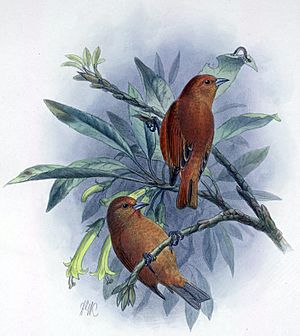Oʻahu ʻakepa facts for kids
Quick facts for kids Oʻahu ʻakepa |
|
|---|---|
 |
|
| Conservation status | |
| Scientific classification | |
| Genus: |
Loxops
|
| Species: |
wolstenholmei
|
| Synonyms | |
|
|
The Oʻahu ʻakepa (Loxops wolstenholmei) was a special type of ʻakepa bird. It used to live only on the island of Oahu in Hawaii, but sadly, it is now extinct (meaning it no longer exists). People saw this bird often during the 1800s.
This bird was a beautiful brick-red color. It was a kind of Hawaiian honeycreeper, which are birds unique to Hawaii. The Oʻahu ʻakepa lived high up in the mountains where there were lots of trees. Female Oʻahu ʻakepa birds were mostly gray with a bit of green.
Contents
What the Oʻahu ʻakepa Looked Like
The Oʻahu ʻakepa had a special beak that was slightly crossed, just like other birds in the Loxops group. This crossed beak helped it open up flower buds. It used its beak to find nectar (sweet liquid from flowers) and small insects to eat.
Where the Oʻahu ʻakepa Lived
This bird loved to live in forests filled with ʻōhiʻa and koa trees. These forests had many flowers and insects, which were the Oʻahu ʻakepa's favorite foods.
Family of ʻAkepa Birds
The Oʻahu ʻakepa was one of three different types of ʻakepa birds. These birds likely spread out across the islands because of weather or by flying to new places. Over time, they became four different groups:
- Hawaiian ʻakepa: This bird is bright scarlet-red. It lives only on the Big Island of Hawaii. It might be the oldest type of ʻakepa.
- Maui ʻakepa: This bird was grayish-orange. We know it existed from fossils found on the Maui Nui islands. People saw it on Maui a long time ago. It was the first type of ʻakepa to disappear.
- Oʻahu ʻakepa: This was the brick-red bird we are learning about. It was seen until around the 1900s when it became extinct.
- ‘Akeke‘e: This is a green bird. It is only found on the island of Kauai.
Why the Oʻahu ʻakepa Disappeared
The Oʻahu ʻakepa became extinct around the 1900s. Many Hawaiian birds disappeared because of new animals brought to the islands, diseases, and changes to their forest homes.
See also
 In Spanish: Akepa de Oahu para niños
In Spanish: Akepa de Oahu para niños


